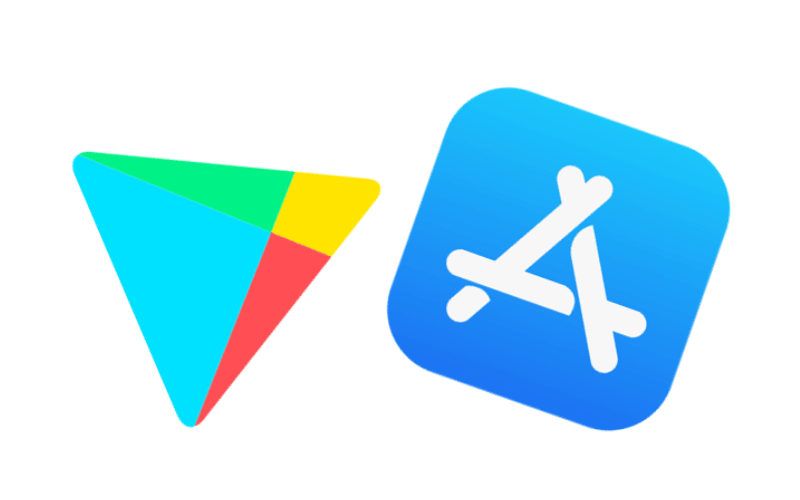Since the market is oversaturated, mobile game players adapted to the influx of games by choosing their next installs more carefully. You can often find statements like “this is a [popular game] rip-off” or “it’s just like that other game” in the review section of app stores. Reviews like these bear a negative connotation and a negative impact on your game which is a story for another time (check this post if you want to know how to get your app reviewed).
Statements like these are a byproduct of mobile gamers’ adaptation to an oversaturated market. They are often a product of badly and inaccurately presented games. To avoid mistakes like these, here is everything you need to know about app store optimization for mobile games in Google Play & the Apple App Store.
But first, what is ASO?
App Store Optimization, or ASO, is a process of optimizing a mobile game in the app stores (Google Play & Apple App Store) to increase its visibility in the respective store’s search.
App Store Optimization serves to increase traffic to an app listing and improve the game’s conversion rate to generate organic app downloads.
We can draw many parallels between ASO and SEO (search engine optimization). Where ASO optimizes apps to increase visibility and conversions to bring more organic traffic, SEO optimizes web sites for a better shot at ranking for more lucrative search terms on search engine pages like Google’s. Just like SEO is important for websites, ASO is crucial for mobile games.

Why is App Store Optimization Important for Mobile Games?
ASO is at the core of mobile game growth. With great app store optimization, you can drive high-quality traffic for free to your app listing.
Since the traffic we get from ASO is organic and free, it will further reduce the cost of user acquisition. User acquisition is already more costly than user retention. Here you can read more about mobile user retention rates.
We can draw an analogy here. Kids in development need lots of healthy food, right? Think about your app in this way. A newborn app needs its daily nutrition to keep growing strong and healthy. In our case, we need to feed our app with healthy traffic so that it can one day outgrow the competition.
Organic traffic, like organic food, is healthier than fake alternatives. A healthy traffic is a sign of a quality app. Even if you end up ranking well for a strong keyword in app stores, without a quality app you will quickly lose your place to a stronger, healthier competitor.
However, it’s important to note that the science behind app store optimization is still developing. Marketing experts in the field don’t know all the sure ways of ranking an app.
The signals by which an app is ranked are still somewhat hazy on the details. What we do know is usually what we see. Ranking a mobile game in app stores requires strong analytical abilities and critical thinking.
With these two powers combined, we can deduce how the stores operate and how does the user base behave. It will also help us to grasp (at first, intuitively) how users search for apps and which keywords have more potential.
But, app store optimization is more than the sum of keywords. App icon, user reviews, app screenshots, and localization play a big role too, to name a few.
The search engines in Google Play and App Store aren’t as sophisticated as the AI behind Google, the world’s leading search engine. Not yet, at least. While there are many parallels that we can draw between ASO and SEO, for example, there also remains much that puts them apart.

App Store Search Ranking Factors
It’s true what they say. Behind every successful app store is a smart mathematical algorithm. App stores use complex algorithms to sort and categorize all app listings based on search query relevance and intent.
The intent behind search queries is user-driven.
This means that after an unknown amount of time, a pattern will emerge. Mobile app store users type keywords in search boxes with specific intent. If they are browsing for an endless runner, they might type in “endless runner for kids”, for example.
The intent is to find an endless runner type of a game easy and casual enough for children to play. As more users type the same query with the same intent, the algorithm picks up the pattern and tries to serve more relevant listings for the entered keyword.
To get to this level of sophistication, app search engines use numerous factors to determine the app to keyword relevancy. Some of them are outlined in our complete guide to ASO.
Both Google Play and the Apple App Store take mobile game name and description into account when ranking an app for a keyword.
But first, let’s talk about keywords.
Do Your Keyword Homework
Sit down, grab a chair, a pen and a paper, and start brainstorming.
Start with your game.
Write down all game features. Be truthful. Lying about your app features can only ruin your chances.
No one likes a deceiver.
Once you come up with a sufficiently long keyword list for your mobile game, you can move on to the next part. 10 to 20 keywords should suffice for the first iteration.
For this part, we will put the pen and paper aside for the Internet. Make a research of all the latest mobile gaming trends but focus on the trends in your game’s genre.
You can use app keywords to play with Google Play’s auto-suggest feature. Throw your keywords in there one by one and see what comes up.
Another great tool for mobile game keyword research is KeywordTool.io. And let us not forget Google’s Keyword Planner.
Keyword research tools serve as a strong starting point. Once you accumulate enough ideas, move on to your competitors. Go through their reviews and descriptions and see what matches your game. You are looking for relevant but not overly popular keywords.
Research your keywords and pick the ones that best describe your game. In the beginning, focus more on long-tail keywords with less competition and slowly transition to more competitive keywords as your mobile game progresses.

Mobile Game Name
Did you know that both Google Play and Apple App Stores use the keywords in your game title as one of the ranking factors?
That’s why you should choose your name carefully. Your app’s title is one of the most important criteria when it comes to ranking.
A mobile game name is crucial because it helps build a brand name. It is also your game’s first contact with a potential player. For this reason, we put the most important keywords in the title, next to a brand name. For example, Idle Miner Tycoon: Mine and Money Clicker Management. In this title, the keywords are “miner”, “tycoon”, “management”.

Apple allows a 30-character long title while Google Play goes up to 50 characters. This is just enough to have your focus keywords right next to your name. The mobile game’s name should also reflect the theme of the game or at the very least the genre. The accompanying keyword can emphasize the type of game or a single, cornerstone feature of your game.

Mobile Game Description
The app name has a specific purpose – to put forth your strongest feature i.e. your unique selling proposition.
For some users, the app name is all that stands between them and the installation of your game. These users browse and explore the app stores, always looking for something new. They are eager to jump in a new game, but they also tend to churn more easily.
Besides explorers, we also have deep divers.
These are the users that like to drown themselves in all the marketing material that exists on an app listing. They will read past your title. They will read your app’s description, look at screenshots, and even go over user reviews before they make the final decision.
It sounds like a lot of hassle for one group of players.
But, once they convert and install your app, the deep divers bring more value to your game. They convert more easily while inside the app and stay loyal for a prolonged period.

Here’s another reason why your mobile game’s description matters.
The algorithm will scan your game’s description for keywords which it will use as a first reference point when putting your game in front of your audience.
Look at your competition and see how well they’ve made their description. Carefully craft your game’s description but only after you’ve done your keyword research. The description box is the largest field available for developers to explain their game. While large, both Google and Apple still limit the character count.
While the character limit for Apple App Store allows only 255 characters, the character limit for a Google Play app description can be 4000 characters long. Try to integrate your keywords naturally throughout your text. This isn’t a spamfest and no amount of keyword stuffing will help your app’s visibility.
Invest in an App Store Promo Video
While writing a good game description and adding screenshots to your app store page is important, there’s nothing like a good promo video. If done right, it contains all the necessary game information and encourages users to download it. It’s the perfect way to present a game. Furthermore, an app promo video can boosts conversions by 40% (StoreMaven).
A less known benefit of promo videos is that they attract high-quality users.
Let me explain.
Since promo videos explain what the game is about, how to play it, what’s the core game loop, how to advance, etc., players who watch them before downloading tend to be more engaged. Why? Because they are better at playing it, understand how everything works, feel connected to the characters, etc. These players also tend to spend more on in-app purchases.
Creating an app store promo video is similar to creating a video ad. However, they’re not the same. Ads usually focus on just one feature/benefit. A promo video should include all of them or at least the most exciting ones. It’s important that you show users how to play the game, but you also need to include your game’s USP.
Once you have the video idea in your mind, try to write and draw it all down. A good way to structure videos is by using storyboards. With storyboards, you can map out everything, frame by frame.
By creating a storyboard, you will get a better idea of what you need to add or remove. Of course, it should go without mentioning that you don’t need to be the best artist in the world.
You just need to draw the outlines, general ideas for shots and think of why you want to include certain elements in each frame. In the end, even if you are not going to be the one creating a video, a storyboard will be a useful tool for your video creator.
For example, you can highlight the most important features and benefits of the game, i.e., cool storylines, interesting characters, a multiplayer feature, leaderboards, etc.
Add captions and music/sound effects to the promo video to make it more interesting.
Don’t hesitate to add transitions, slow-mo, zooms, freeze frames, and other visual effects. Also, at the same time, try to keep it balanced and not overdo it.
Moreover, try to avoid too much text and switch the focus of your storytelling on the visuals. But, if you are going to add text, make sure it is stylized, maybe even try purchasing or customizing a font. This way, by having your own font, you will also work on your brand recognition.
Finally, finish off with a call to action – install now, play now, download for free, etc.
Just like any other ASO element, you can test different versions of a promo video and see which one works best.
However, make sure you include real gameplay footage instead of cinematics, as advised by Google Play and Apple App Store. That way you don’t mislead players and avoid them being disappointed later on.

Don’t Forget to Localize
Localization is a crucial part of app store optimization that often gets overlooked. It can be a total game-changer because it allows you to reach a global audience. Plus, Google Play and Apple App Store give advantage to localized games because localization improves user experience.
But don’t think it’s enough to localize just the game itself.
You also need to localize app store ranking factors like keywords, description, icon, images, promo video, and even the game title. Basically, every single aspect of your app store page.
Why?
According to MobileAction, localizing an app results in 130% more downloads and a 25% increase in revenue.
The Apple App Store is available in 155 countries and you can localize content for 40 different languages. For Google Play, you can choose from 77 different localizations. However, that doesn’t mean you need to localize for all languages – choose the ones based on your target market.
Conclusion
App Store Optimization is the leading force behind driving organic traffic to your mobile game.
But don’t forget – ASO in an on-going process.
It’s not something you should do only once.
Only through trial and error can you achieve success with app store optimization. Try out different keywords, screenshots, titles, app icons, and descriptions to find your perfect formula. And make sure to split test everything.
App Store Optimization for mobile games is a lot of work for one developer, but it could be the turning point for your mobile game. If you have any questions, the ASO team at Udonis will welcome the opportunity to answer them.







Comments